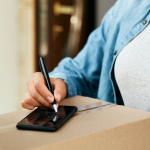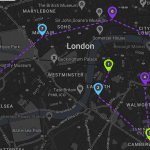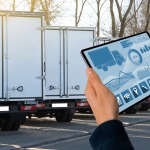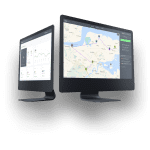Post summary:
- Why you should focus on providing a great customer experience
- Customer experience in last-mile delivery
- What is a last-mile delivery software?
- How last-mile delivery software can help boost customer experience
What is a great customer experience and why it is so important
 Customer experience is the perception a customer has of a brand. As discussed before, it has become the most important factor to affect business performance.
Customer experience is the perception a customer has of a brand. As discussed before, it has become the most important factor to affect business performance.
Keeping up with the ever-changing customer demands is not an easy job. Unfortunately, this is just the thing modern supply chain and logistics enterprises have to thrive for.
Statistics say that as much as 86% of buyers will pay more for products and services when having great Cx, in addition to buying more from those companies. While providing top-notch Cx requires constant work, it doesn’t take much to scare away customers.
One of three buyers says that they would easily give up a brand they used to love after just one bad experience. As people are likely to share their experiences with friends and family, this will have a big effect on the company’s overall performance.
But what distinguishes a good Cx from a bad one? Personalization is the keyword to keep in mind.
People want customer service that is fast, reliable, convenient and has a human touch to it. Companies that have invested in the latest technology and the amazing design will not succeed when the most meaningful aspects of customer experience have been left aside.
Great customer experience in last-mile delivery
The way businesses execute their last-mile deliveries can make the difference between good and bad Cx.
Customers are becoming more demanding and want to have more control over when or where to receive their parcels. In simpler words, how dynamic and transparent the last mile fulfillment is can be the differentiator between two competitors.

According to statistics, 83% of people say that knowing the delivery time of their parcel is the number one service an online brand can provide. Providing real-time visibility about the order status increases transparency and helps to build trust with customers.
As modern customers are mostly on the go, there is a good chance that they might not be available to receive their delivery at a particular time. That’s why delivery flexibility is another important factor to consider for last-mile delivery businesses.
Fortunately, technology has evolved with increasing customer demands and a well-integrated last mile solution can help enterprises deliver customers the experience they are looking for.
In addition to enhancing shipment visibility, technology introduction will also help companies to:
- boost operational efficiency
- include last-minute requests
- be more proactive
- deal with on-demand requests better
- easily communicate any changes to both the customer and on-field employee
- prevent delays
- prevent customer anxiety with real-time tracking option
What is last-mile delivery software?
The last mile is the most important, but also the most time-consuming and expensive element in the shipping process. Its’ prime objective is to get the parcel to the customer as fast as possible.
Last-mile is also considered to be the key to customer satisfaction. Done correctly, it can save companies a lot of money and make their business more efficient.
Last-mile delivery software is a solution with numerous features that help businesses make their last-mile delivery more profitable. It will help boost customer loyalty and benefit overall business operations.
For companies that want to improve their customer experience, last-mile delivery software is the solution to go for.
The most common features of last-mile delivery software are:
- route optimization
- task management and assignment (auto-dispatch)
- real-time status updates, notifications
- electronic proof of delivery
- fleet reports and analytics
- real-time tracking
Last-mile delivery software for great Customer experience
According to Gartner, more than two-thirds of companies now compete primarily based on Cx. So, to stand out, businesses have to invest in providing the best experience for their customers.

A professional last-mile delivery software can boost Cx in multiple ways:
Real-time visibility of delivery status
Last-mile software makes the delivery process more transparent and allows customers to be up-to-date with the order status.
Real-time notifications provide information about the location of their parcel when it will be delivered and by whom. Giving customers a head-up about any delays that might occur is also important to reduce the risk of bad Cx.
Some software even allows to send a tracking link to the customer, so they can see exactly where the courier is and when they can expect their package to arrive at their location.
This helps customers feel appreciated and special, thus boosting their trust and creating a better customer experience.

Flexibility of delivery
Modern-day customers, especially millennials, are always on the go. They might not be available at a certain time or might even want to change the delivery location. Providing a flexible and customizable delivery will certainly give businesses an advantage.
Last-mile delivery software allows customers to contact the delivery person by chatting with them online or even giving them a call. Customers might want to change the delivery time, location or just give better instructions about where exactly to leave the package.
Allowing the customers to feel that everything is at their fingertips positively impacts their trust and increases the chance of great feedback from them.

Speed of delivery
Inefficient routes cause poorly managed time and often cause delays for the customer.
With e-commerce giants like Amazon constantly raising customer expectations, same-day deliveries have become a norm. According to PwC’s Global Consumer Insights Survey, as much as 41% of consumers are willing to pay an extra fee for same-day delivery.
Last-mile delivery software allows companies to use route optimization algorithms that ensure that drivers complete most deliveries in the least amount of time.
Taking different variables like delivery windows, driver availability, location proximity, etc. into consideration, allows deliveries to be completed as fast as possible and helps last-mile delivery businesses keep up with the high customer demands.
Conclusion
Advanced last mile software includes functionalities that automate processes and accelerate information sharing between the delivery company and its customers. So, to ensure customers are happy and to stay ahead of the competition, it’ll become imperative to boost supply chain and logistics with advanced last-mile delivery software.
The selection of providers and the features they offer is vast. We recommend using the free trial option if possible, to get a better overview of the software and test its suitability for the company.
You can trial GSMtasks last-mile delivery software for FREE for 14 days! Just sign up – it only takes a minute!
What is last-mile delivery?
Last-mile delivery is the final leg of the e-commerce supply chain that physically connects brands with consumers through purchase delivery. Goods are transported from a warehouse or a distribution centre and arrive either at a consumer’s home, business, or parcel locker. For the shipper, last-mile delivery is the most complex and expensive part of the product’s journey.
The goal of superior last-mile delivery is to enable every delivery to reach its destination on time, accurately, efficiently, and sustainably.
What does the best last-mile delivery software include?
The best last-mile delivery software programs have the following functionalities:
- Telematics
- Dashcams with hazard detection capabilities
- Driver safety scorecards
- Real-time global positioning system (GPS) tracking
- Geofencing
- Diagnostic fault codes and alerts
- Maintenance reminders
- Automated engine performance recording
- Electronic logging of driver’s on- and off-duty hours
- Instant inspection report generation
- Computerized scheduling, route planning, and dispatch workflows
- Electronic fuel consumption tracking and International Fuel Tax Agreement (IFTA) tax reporting
- Two-way messaging systems
- Load boards
- Mobile (Android, iOS, etc.) and desktop software availability
- Flexible and multiple system integrations
Superior last-mile delivery solutions will usually include:
- 24/7 customer support
- Intuitive reporting dashboards
- Ease of use
- Updates on regulatory changes
- Accurate data capture and analytics
- Scalability
- Configurable to your business requirements
- Unlimited number of users
- Secure and centralized data storage
How does last-mile delivery help supply chains?
Last-mile delivery is the final step in the supply chain, where goods are transported from a transportation hub or warehouse to the customer’s location. Here’s how it typically works:
- Order Placement: The customer orders online or through a mobile app. The retailer or logistics company receives the order and processes it.
- Order Fulfillment: The order is picked, packed, and prepared for shipment at the warehouse or fulfilment centre. The shipment is then loaded onto a delivery vehicle, such as a truck or van.
- Route Optimization: The delivery vehicle’s route is optimized to ensure that packages are delivered most efficiently. The route may be optimized based on factors such as distance, traffic, and delivery time windows.
- Last Mile Delivery: The driver delivers the package to the customer’s location, which could be a residence, business, or public location such as a locker or pick-up point. The driver may also use technology, such as GPS and mobile apps, to navigate to the customer’s location and communicate with the customer in real time.
- Delivery Confirmation: The driver confirms that the package has been delivered, often by obtaining a signature or using a photo capture system, and the order is marked as complete.
Last-mile delivery can be complex, involving navigating challenges such as traffic, limited visibility, and managing returns. However, advancements in technology and new delivery methods, such as drones and autonomous vehicles, are helping to improve last-mile delivery and make it more efficient and cost-effective.
What are the current challenges of last-mile deliveries?
Last-mile operations have never been so complex. Increased variables in how, where and when deliveries depart and arrive give shippers and carriers alike greater flexibility, but they also provide greater complexity to the last mile.
Multiple challenges contribute to the last mile problem. One challenge for shippers and carriers is a lack of efficiency, which contributes to the expense of the last mile. Another challenge is providing real-time visibility regarding a delivery’s location for all stakeholders.
Amazon set the bar high with its ever-increasing ability to deliver in shorter time frames while also notifying the consumer about the transit delivery details. Brands with and without their own dedicated fleets strive to live up to the “Amazon effect,” and adhere to the promised delivery dates and times for consumers.
Consumers want visibility into their deliveries but expect faster delivery speeds. Keeping all stakeholders happy while delivering in increasingly shorter time frames most cost-effectively and efficiently is the last mile problem.
In short, the last-mile delivery problem impacts all companies. In today’s world, every company wants to deliver products quickly, efficiently and provide superior customer experiences while working in an increasingly complex and competitive landscape.
What is a vehicle tracking system?
A vehicle tracking system is an electronic device installed within the vehicle to monitor that vehicle’s activity. It’s often paired with fleet management software to simplify fleet tracking.
The most common vehicle data that the system collects are:
- Location
- Speed
- Fuel consumption
- Driver behavior
- Vehicle fault codes
Companies that own or lease a fleet of vehicles often invest in vehicle tracking systems to improve the efficacy of their fleets. By using a vehicle tracking system with powerful fleet management software, fleets can:
- Uncover the best and quickest route to their destination.
- Improve the driving habits of their commercial drivers.
- Drastically reduce fuel consumption.
- Get better insurance premiums.
- Quickly and comprehensively conduct preventive maintenance work.
- Comply with government regulations.
What are the challenges in last-mile logistics?
Last-mile delivery is a complex process that involves several challenges that can impact delivery times, costs, and customer satisfaction. Here are ten common challenges in last-mile delivery:
- Traffic Congestion: Traffic congestion can significantly impact delivery times, making it difficult for drivers to reach customers on time.
- Limited Visibility: Last-mile delivery can be challenging to manage because tracking packages once they are out for delivery is difficult, leading to limited visibility for logistics companies and customers.
- Missed Deliveries: Missed deliveries are a common challenge in last-mile delivery, leading to additional costs for logistics companies and customer frustration.
- Managing Returns: Returns management is a complex process in last-mile delivery, requiring significant resources and logistics coordination to ensure that packages are returned to the appropriate location and processed in a timely manner.
- Delivery Window Constraints: Customers often have specific delivery windows that can be challenging to meet, leading to missed deliveries and reduced customer satisfaction.
- Cost Management: Last-mile delivery can be costly, particularly in urban areas where traffic and other challenges can increase delivery times and costs.
- Unpredictable Demand: Last-mile delivery can be challenging to manage due to unpredictable demand patterns, leading to inefficient use of resources and additional costs.
- Security and Theft: Last-mile delivery packages are at risk of theft and damage, resulting in significant financial losses for logistics companies and customer frustration.
- Environmental Impact: Last-mile delivery can have a significant environmental impact due to emissions from delivery vehicles and packaging waste.
- Limited Access: Last-mile delivery can be challenging in remote and rural areas where access to roads and other infrastructure may be limited, leading to increased delivery times and costs.
How much does last-mile delivery cost?
Last-mile delivery accounts for 53% of the total cost of moving a product across first, mid and last miles. Pinpointing an exact number on last-mile costs is difficult as each delivery differs. However, the average next-day shipping cost for a retailer is $27 per package, while for Amazon, it’s $5.





